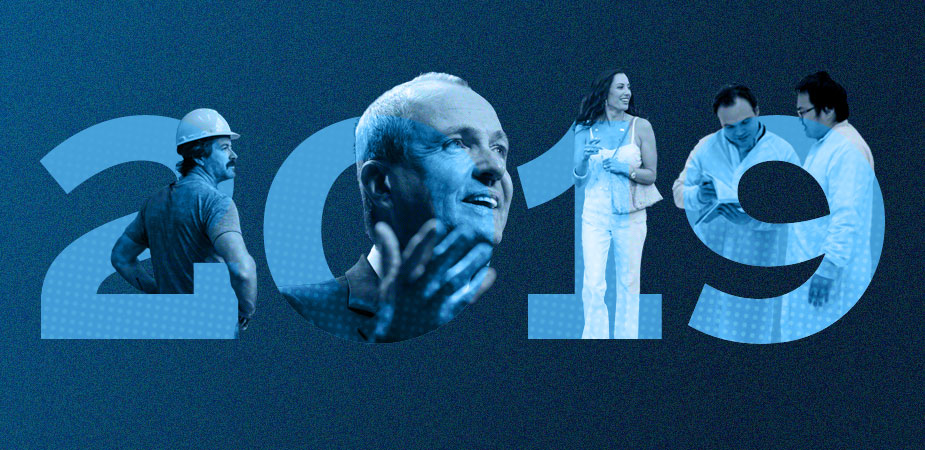The shifting sands of commercial real estate helped produce some of the year’s top stories in 2018. From the nationwide courting of Amazon’s HQ2 to the inception of Opportunity Zones, CRE news spread far beyond its typical reach.
With stories of success and potential industry disruptions, new trends (as always) begin to emerge. To help identify new commercial real estate trends and clarify what’s to come in 2019, we went to the source. We asked key players in New Jersey’s commercial real estate market about the past year and what they believe is in store for the year ahead.
Retail

Justin Korinis | Sabre Realty
Q: In 2018, what types of influences guided the retail industry? Were there more positive or negative indicators?
A: 2018 was a defining year in retail for a lot of reasons. As the changing landscape started to come to a head, it created clear winners and losers. We entered the year in a “retail apocalypse” with many articles and prognosticators touting the death of brick and mortar retail, but it was merely a tipping point where those companies built for the next evolution were allowed to shine as the dinosaurs died. Overall, we saw a lot of space come back to the market this year with massive bankruptcies – most notably Toys R Us, Kmart and Sears. However, we also saw a lot of absorption from discount and off-price retail as well as internet-proof retail, e.g. restaurants, fitness (especially boutique fitness) and entertainment.
Q: Retail is obviously going through a transition. Do you think it is in the early, middle or late stages of that transition and what are the big signs you’re looking for in 2019 to help gauge that progress?
A: This is a difficult question to answer because, on the one hand, I would say that this recent transitional period is nearing the end of the cycle. I think most concepts that have survived this recent tidal wave of bankruptcies and closures did so by insulating themselves to a certain degree. This does not mean that there won’t be new retailers on the chopping block in the next couple of months, but the pace will slow.
That being said, overall, this transitional period is a small microcosm of a larger, constantly shifting landscape. In the same way that a large earthquake has a damaging, immediate impact on an area, it’s merely a symptom of a larger, ongoing tectonic shift. As consumer habits and tastes change due to the impact of technology, retail will need to continually evolve. Besides simply online shopping, technology such as Uber, Seamless, virtual reality, geotagging and data mining are all having significant impact on how we purchase goods, services and experiences today.
Q: What trends do you see continuing into 2019? What challenges do you see continuing into 2019?
A: The big trend that we’ve seen over the last year or so that I see continuing into 2019 is the rise of experiential retail. This means entertainment concepts like bowling, movies, VR gaming, restaurants, fitness, etc. These are all things generally considered internet-proof, or at least internet-resistant.
Boutique fitness is gaining tremendous popularity. In many cases, talk of fitness and classes have become the topic at the water cooler at work, and being seen at the hot class with the “it” trainer has replaced being seen at the hot nightclub. The 22-45 year old segment has really placed a premium on fitness and are willing to spend a large portion of their disposable income on it. It’s not uncommon to see people doing 3-5 classes a week at 2-3 different studios.
Casual dining restaurant sales have seen year-over-year declines the last few years, and much of this can be attributed to the rise of quality fast casual restaurants like Chipotle, Honeygrow, Shake Shack and Cava. In 2018, this was temporarily abated as most casual dining restaurants started employing the services of Seamless, DoorDash, GrubHub, etc. to start delivery for the first time. This has shown positive growth for many concepts, though by nature, this increase is only temporary. Polished casual concepts and “chef-driven” restaurants are the current darling of many landlords as the atmosphere, a typically more up-scale vibe, is very in demand. Consumer palates and level of education about food has evolved and the quality of the ingredients and preparation of the food have become a focus. Blame the generation raised on the Food Network and celebrity chefs.
Coworking

Sean Donohue | Bell Works CoLab
Q: With the new age of coworking still in its infancy, trends come and go more often than those in established lines of business. In 2018, were there specific trends that you adopted? Anything you avoided?
A: In 2018, we followed a trend by adding more walls to our footprint. Specifically there has been an increased demand for privacy from current and prospective members coming in for private offices and team suites. Even companies that are utilizing the open floor plan zones of our coworking spaces are looking for increased privacy at their workstations and more multipurpose areas to have a quiet phone call. People still love the shared amenities and access to collaborative space, but increasingly they look to take more sensitive client calls in quiet, private rooms.
Q: The rise of coworking has dramatically impacted the real estate market overall and has generally been looked at as “the enemy” of traditional real estate players. How do you see the relationship between coworking and traditional real estate businesses growing in 2019? Do you see that divide widening, or do you see the businesses becoming more symbiotic? Why?
A: I think we are entering a new era in the coworking industry – a more mature shared/flexible office space year. These traditional real estate players are starting to bring coworking under their corporate umbrellas. This does two primary things: It validates the asset class as something that will not be going away or slowing down any time soon and it will start to create a more diversified coworking marketplace.
Established coworking startups like WeWork and Industrious for example led the way, but more as venture startups focused primarily on urban centers. These traditional players jumping into the ring will create new coworking options in markets that previously had few shared space options or none at all. I think the tone of these spaces will also be bit more balanced between a cool, hip culture and professional space for conducting work. I see the gap closing or completely blurring together over the next year. I think coworking as a whole is growing up and it is going to be an exciting evolution. It will be a big win for both sides.
Q: Is there a trend you’re seeing as a person in the business that the average person might have missed?
A: Something that I do not hear about as much in the news but see almost every day are new clients who have made large investments in home offices and now need a coworking space. It seems that particular group just doesn’t find working from home in an office all that it is cracked up to be. They feel more energetic coming to an office with others in a professional environment. This really goes back to the roots of how coworking came about. It was all about not working alone and have a sense of camaraderie. 2 out of 3 of our active members cite that as a reason for being here. I think it shows that no matter how much the coworking industry evolves in 2019 at its core you can still trace the growth of the industry right back to its roots.
Developer

Alexander Cocoziello | Advance Realty
Q: As a business, how is the political and economic landscape affecting your thinking/planning for 2019? How does the threat of rising interest rates impact your thinking/planning as well?
A: The political and economic landscape, both federally/macro and state/micro, factor heavily into our fundamental investment analysis.
Top down, following the presidential election in 2016 and the fiscal reforms which followed, business confidence and consumer sentiment increased and therefore investment increased. These are exemplified by the burgeoning industrial market, strong demand in the multifamily sector and growth in suburban office rents, albeit, due to consumer preferences, corporations have invested more so in New York as the demand for talent remains paramount.
The retail market, unfortunately, has experienced tepid investor demand (with some exceptions) due to the proliferation of e-commerce. It is our view that investors have priced in the continued growth in market share of e-commerce.
In 2019, our view is that demand for real estate assets will increase, but all eyes will be on the federal reserve. We choose to be cognizant of the macro/geopolitical risks, but these do not factor heavily into our investment analysis unless they affect the fundamental credit quality of the tenant or thesis of the sector as a whole. Closely watching monetary policy rhetoric from the Fed will prove to be prudent.
Because our belief that the federal reserve will look to increase interest rates in 2019 until they fulfill their dual mandate, despite pressures out of Washington to limit the hikes, it is prudent to refinance and lock portfolio interest rate risk and to be selective about new acquisition of interest-rate-sensitive investments.
Q: Do you believe that “Opportunity Zones” will be the hot topic of 2019? Do you believe that we will look back at the related legislation as having had a positive impact on the development market in New Jersey?
A: Yes, absolutely. While the fundamental decision to acquire or invest in a certain geographic area remains the same, we do expect a significant amount of capital to flow into opportunity zone funds and demand for real estate in locations which already have positive demographics or other demand factors will only accelerate investment into these towns. A challenging dynamic will be joint venture structures considering the long-term nature of the investment.
Q: Hoboken was one of the early urban redevelopment successes for NJ in the late 90s and early 2000s and has been a ‘hot neighborhood’ ever since. Now Jersey City has been the ‘hot neighborhood’ for the last few years and has seen massive redevelopment. What area do you believe will be the next for development? Will it take shape in 2019?
A: Areas along the coast including Hoboken and Jersey City have not seen typical rental increases for the past 18 months or so, mainly because of the supply dynamic in these tier-one markets. Markets which will continue to attract renters and therefore capital/investment are the low-cost provider to the tier-one markets.
Obviously, I am incentivized to mention Harrison as we have been heavily invested in that community for quite some time, but our thesis has proven correct. We believe in Harrison, Morristown, Montclair, etc. These towns are one step further from New York, but have great downtowns and access to railroads and highways. Further out, cities located close to highways with direct access to New York are next. Over the long term, because of the advent of autonomous vehicles, these locations will be most attractive if developers are able to provide city-like amenities to end-users.
Q: So much of the focus in development for the last two decades has been in cities. Is 2019 going to be the year of the suburbs, or are we still far from that?
A: It’s already begun…
State Incentives

Tim Sullivan | New Jersey EDA
Q: The new administration has made it clear that they will be focusing on the “innovation economy” over the next three years. How do you define the innovation economy, and what are the guidelines for a business to be able to consider themselves part of the innovation economy?
A: Governor Murphy’s vision for making New Jersey the State of Innovation is driven by the power of the innovation sector to create more and better jobs across the State. A stronger and fairer economy will focus on growing our innovation economy and capturing the economic multiplier effects of those industries – up to five additional jobs are created by each job in the innovation economy.
To achieve the Governor’s vision, we have renewed our focus on supporting key growth sectors, including life sciences, information and high tech, clean energy, advanced manufacturing, advanced transportation, logistics, finance and insurance, food and beverage, and film and digital media. We have proposed smarter, more targeted incentives and programs to bolster high-wage, high-growth sectors that bring money into the state and support sustainable living for our residents.
Q: The New Jersey real estate market has been plagued with an abundance of obsolete, vacant office space that is in desperate need of renovation or repurposing. How is the state working with developers to incentivize such investment, and what are some key things that you would recommend developers be aware of when considering projects in 2019?
A: A number of demographic and economic trends that have resulted in an outmigration of jobs and population, leaving many office parks and shopping malls that once thrived now underutilized or vacant.
On December 3rd, the NJEDA began accepting applications for the 21st Century Redevelopment Program, which will provide grant funding to assist communities with developing solutions for repurposing local vacant or underutilized commercial and retail properties.
The 21st Century Redevelopment Program will launch as a pilot program with a total of $250,000 in funding available in the form of grants of up to $50,000 per recipient.
While Governor Murphy’s overall economic development strategic plan – “The State of Innovation: Building a Stronger and Fairer Economy in New Jersey”, unveiled on October 1, proposes tax credit programs, they are included as a targeted economic development tool, not a standalone strategy.
Under the leadership of the Governor and Legislature, this is likely to include new, more targeted incentives, including:
NJ Forward Tax Credit Program – The Murphy administration will propose a new job creation tax credit, that preserves the best features of the existing program while also making important reforms that recognize the state’s constrained fiscal resources and improved economic conditions since the depths of the Great Recession. The proposed program includes an annual cap.
NJ Aspire – A proposed place-based gap financing tool to help catalyze investments in commercial, residential, and mixed-use (including parking) projects, with a particular focus on cities, downtowns, and suburban neighborhoods served by mass transit.
Expanded Brownfields Program – New Jersey has an existing brownfields program, but we believe a more robust investment program, in partnership with the Department of Environmental Protection is needed.
Historic Tax Credit Program – Repurposing old buildings to house our new ideas will be key to preserving our history and redeveloping historic assets, particularly in urban areas. A proposed a state historic preservation tax credit program will be proposed to help revitalize buildings across the state.
New Jersey Innovation Evergreen Fund (NJIEF) – The NJIEF would raise capital by competitively auctioning state tax credits (over five years) to New Jersey corporations and partnering with private venture capital firms to co-invest these funds. Venture capital firms and the Evergreen Fund would then make joint investments in New Jersey-based startups, targeting life sciences, financial technology, digital media, and cybersecurity startups in particular.
Q: What are some of the key challenges facing the state economically that you believe will see the most improvement in 2019?
A: Governor Murphy recognizes the priority that must be placed on talent development and higher education for the goals of his economic development strategic plan to be achieved. Investment in people will serve to create opportunities for viable careers for New Jerseyans, while feeding the pipeline of skilled talent employers seek today, and anticipating the skills that will be needed in the coming decades.
Since taking office, Governor Murphy has advanced initiatives for creating more and better career opportunities for New Jerseyans. In June, he launched the New Jersey Apprenticeship Network to bolster on-the-job training in advanced manufacturing, clean energy, and other high growth sectors and strengthen the connections between our education and workforce systems. The Department of Labor and Workforce Development, the Department of Education, and the Office of the Secretary of Higher Education (OSHE) will lead the buildout of this network.
In May, the Governor announced two initiatives that will help ensure New Jersey’s labor pool keeps pace with new career opportunities by strengthening the link between industry and academia: The Science Technology Engineering and Math (STEM) Loan Forgiveness Program will reduce State and Federal student loan obligations for college graduates in high-growth STEM occupations that choose to work in New Jersey. For current students, the NJ Career Accelerator Internship Program offers paid internships to be administered through the New Jersey Department of Labor and Workforce Development.
Another initiative designed to drive economic activity by connecting industry with the academic community is Research with NJ an online database spearheaded by the NJEDA and OSHE. Research with NJ provides local, national, and international commercial enterprises, ranging from entrepreneurs and start-ups to global corporations, with insight into groundbreaking research taking place within the state’s network of six research universities. This includes information on subject matter experts, facilities, publications, intellectual property, news, and events that can help Research with NJ users forge partnerships and build innovative new businesses and products based on the latest scientific and technological breakthroughs. Research with NJ currently includes nearly 3,500 faculty profiles from five public and private universities — New Jersey Institute of Technology, Princeton University, Rowan University, Rutgers—the State University of New Jersey, and Stevens Institute of Technology. Additionally, data from Montclair State University, which was designated as a research university in 2017, is now being integrated into the Research with NJ database. The portal can be found at www.researchwithnj.com.
To read Governor Murphy’s full economic plan, please visit: The State of Innovation: Building a Stronger & Fairer Economy in New Jersey

